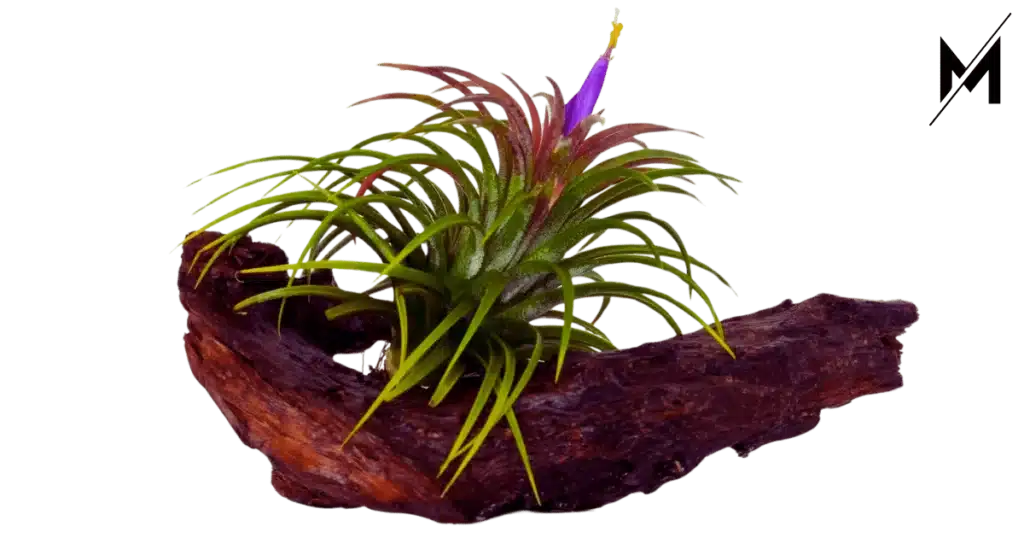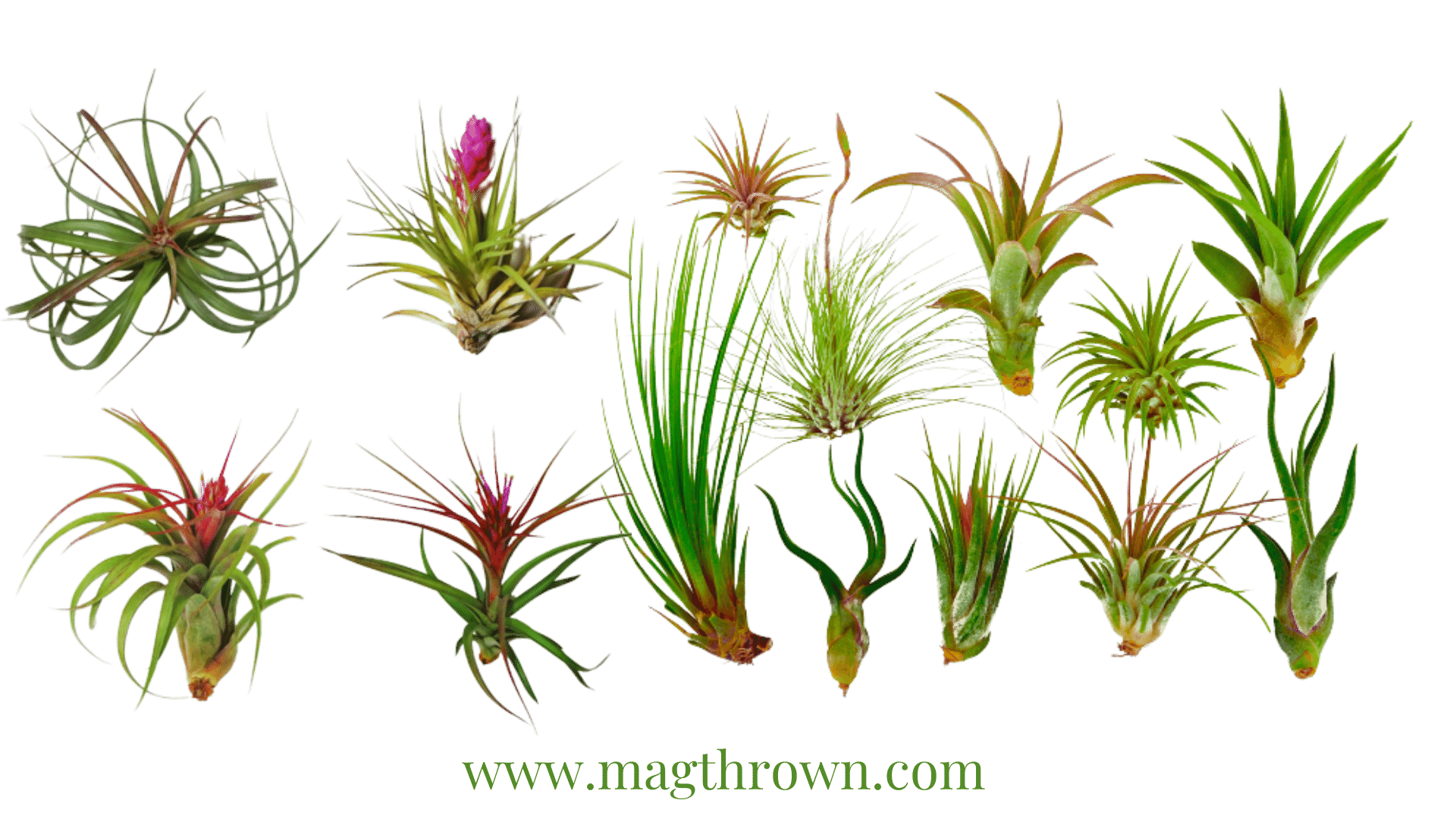Introduction
Air plants, scientifically known as Tillandsia, are a group of unique and fascinating plants that charm both botany fans and home decor lovers alike. These remarkable plants belong to the Bromeliaceae family and are known for their typical ability to thrive without soil. They are true wonders of nature, and in this comprehensive article, we will delve deeper into the interesting world of these plants.

Adaptation to an Aerial Lifestyle
One of the most remarkable features of this plant is its conversion to an aerial lifestyle. Unlike most plants, this plant does not need soil to grow and derives nutrients from the air, water, and light. They often grow on tree boughs, rocks, or other surfaces, using their roots primarily for port. This adaptation has allowed these plants to conquer diverse habitats, from tropical rainforests to arid deserts and even the high mountains of the Andes in South America.
Unique Aesthetic Appeal
Air plants are celebrated not only for their unique growing habits but also for their beautiful appeal. Their visible appearance and versatility have made them popular choices in inside decor. These plants come in different shapes and sizes. Some are very small, only about an inch long, while others are much bigger and can be several feet long. The leaves of these plants can be of different colors, such as silver-gray or vibrant green. Some air plants even have a touch of pink, red, or purple. Air plants are often used in creative displays, placed in glass terrariums, suspended from strings, or arranged on chunks, creating living works of art that can enhance any space.
Minimal Maintenance Requirements
One of the most significant advantages of these plants is their minimal maintenance requirements. Unlike traditional potted plants, air plants do not need regular watering or complicated soil mixtures. Their care is relatively straightforward, and they thrive with a few simple steps. To care for air plants, you must provide them with bright, indirect light, such as near a window or under artificial grow lights. Plants are typically watered by either spraying them with a mist of water or immersing them in water for about 20 to 30 minutes every 1 to 2 weeks, depending on the humidity level in your surroundings. You watered by either spraying water in mist or immersing it in water for around 20 to 30 minutes every 1 to 2 weeks, depending on the humidity level in your surroundings. If the environment is dry, you may need to water more often.
Air Plants in the Wild
In their natural habitats, these plants play essential roles in ecosystems. They provide shelter and nesting sites for various small creatures, such as insects and birds. Additionally, air plants contribute to the overall biodiversity of the areas they inhabit. In some regions, indigenous communities have used air plants for their medicinal properties and crafts, demonstrating the cultural significance of these unique plants. Furthermore, these plants are part of intricate food webs, as they rely on various pollinators and seed dispersers, showcasing their ecological importance.
Growing Your Own Air Garden
If you are interested in the beautiful world of air plants, making your own “air garden” can be fun and artistic. You can start by buying these plants from local farms, online stores, or even other plant lovers who are willing to trade. Adding a variety of kinds and types to your air garden can give it more depth and interest. Try out different ways to show your art, such as hanging planters or putting them on a wall, and let your creativity shine. With this project, you can bring the beauty of these plants into your home while also being creative.
Air Plants and Their Unique Varieties
Air plants are a diverse group of plants, and each variety has its distinct features and characteristics. Let’s explore some of the unique air plant varieties that you can add to your collection.
Tillandsia Ionantha – The Miniature Marvel
Tillandsia ionantha is one of the most popular air plant varieties. It’s known for its small size, vibrant green or red coloration, and the distinctive trichomes that cover its leaves. This miniature marvel is a perfect addition to terrariums and small decorative arrangements.
Tillandsia Xerographica – The Majestic Giant
In contrast to the petite Tillandsia ionantha, Tillandsia xerographica is a majestic giant among these plants. Its silvery-gray, curly leaves create a striking visual impact, making it a focal point in any air plant display. Due to its larger size, it requires a bit more space but is equally low-maintenance.
Tillandsia Caput-Medusae – The Unique Spiral Shape
Tillandsia caput-medusae is known for its spiral or curly leaves that resemble the snakes on the head of Medusa from Greek mythology. This unique shape adds a touch of whimsy to your air plant collection and can be a conversation starter in any setting.
Caring for Your Air Plants – Tips and Tricks
Proper care is essential to keep your air plants healthy and thriving. Here are some tips and tricks to help you nurture your air plants.
Watering Techniques
These plants can be watered by misting, soaking, or dunking. Depending on the size and environmental conditions, choose the method that suits your plants best.
Light Requirements
Ensure your air plants receive adequate indirect light, as they thrive in bright but not direct sunlight.
Humidity and Temperature
Maintain a suitable humidity level and temperature range for your indoor air plants.
Fertilization
Although air plants derive nutrients from the air, occasional fertilization can enhance their growth. Use a diluted, air plant-friendly fertilizer.
| Species | Scientific Name | Habitat | Description | Care Tips |
|---|---|---|---|---|
| Tillandsia ionantha | Tillandsia ionantha | Tropical forests | Small, vibrant green leaves turning red when blooming | Bright, indirect light; misting or soaking weekly |
| Tillandsia xerographica | Tillandsia xerographica | Arid regions of Central America | Silvery-gray leaves, curly appearance | Moderate indirect light; soak in water once a week for 30 minutes; good air circulation |
| Tillandsia stricta | Tillandsia stricta | Brazil, Argentina, Uruguay | Bright green leaves, blooms in vivid colors | Moderate to bright indirect light; misting or dunking twice a week; good airflow |
| Tillandsia capitata | Tillandsia capitata | Central America | Rosette-forming, silvery-green leaves | Moderate indirect light; misting or soaking once a week; adequate air circulation |
| Tillandsia bulbosa | Tillandsia bulbosa | Central and South America | Bulbous base with curly, thin leaves | Bright, indirect light; soak in water for 1-2 hours weekly; gentle drying upside down |
(FAQs) about air plants
What are air plants?
Air plants, scientifically known as Tillandsia, are unique plants that don’t require soil to grow. They absorb moisture and nutrients through their leaves from the air around them.
How do air plants get their nutrients?
Air plants absorb nutrients and moisture through tiny scales on their leaves called trichomes. They take in water and nutrients from the air, rain, and occasional fertilization.
Where do air plants grow naturally?
Air plants are found in diverse habitats such as forests, deserts, and mountains across Central and South America, as well as the southern United States.
How do you care for air plants?
Care includes providing bright, indirect light, occasional soaking or misting to hydrate them, good air circulation, and avoiding waterlogged conditions.
Can air plants live indoors?
Yes, air plants can thrive indoors as long as they receive adequate light, proper watering, and good airflow. They’re popular as indoor plants due to their low maintenance.
How often should I water my air plants?
Watering frequency depends on the environment. Typically, misting 2-3 times a week or soaking for 20-30 minutes once a week works well. Adjust based on humidity and temperature.
Do air plants need fertilizer?
Yes, but sparingly. Use a water-soluble fertilizer formulated for air plants. Dilute it more than usual and apply once a month during the growing season.
Can I display air plants in different ways?
Absolutely! Air plants can be placed in various creative displays like terrariums, mounted on driftwood or rocks, in hanging containers, or simply placed in decorative bowls.
How do I revive a dehydrated air plant?
Soak the air plant in room temperature water for a couple of hours, then allow it to dry thoroughly upside down to prevent water from accumulating in its base.
Do air plants bloom, and how often?
Yes, air plants bloom! Depending on the species, they typically bloom once in their lifetime, usually producing colorful flowers. The bloom cycle can vary from several months to years.
Air Plants: A Unique Addition to Your Life
Incorporating air plants into your life can bring a touch of nature’s wonder and creativity into your surroundings. These captivating plants are not just decorations but living, breathing organisms that can thrive in harmony with minimal effort. Whether you’re a seasoned gardener or a newbie in the world of plants, these plants offer an opportunity to explore the natural world and express your artistic side through unique displays. Embrace the allure of these plants and let them enchant your life with their delicate charm.

